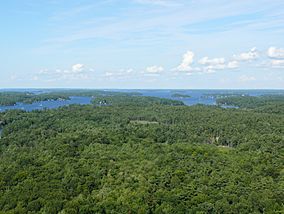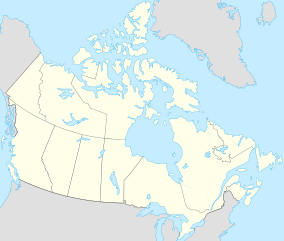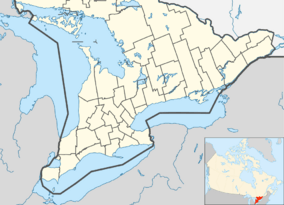Thousand Islands National Park facts for kids
Quick facts for kids Thousand Islands National Park |
|
|---|---|
|
IUCN Category II (National Park)
|
|

Aerial view of Thousand Islands National Park
|
|
| Location | United Counties of Leeds and Grenville, Ontario, Canada |
| Nearest city | Brockville, Ontario |
| Area | 24.4 km2 (9.4 sq mi) |
| Established | 1904 |
| Governing body | Parks Canada |
The Thousand Islands National Park is a beautiful natural area in Ontario, Canada. It was created in 1904 and used to be called the St. Lawrence Islands National Park. You can find it along the 1000 Islands Parkway, right in the famous Thousand Islands area of the Saint Lawrence River.
The islands in the park are actually the worn-down tops of very old mountains. This special rocky area, called the Frontenac Arch, connects the Canadian Shield from Algonquin Park in Ontario to the Adirondack Mountains in New York.
This park is made up of 21 islands and many smaller islets. It also includes two areas on the mainland and a visitor centre at Mallorytown, Ontario. It is one of Canada's smallest national parks, covering a total of 24.4 square kilometres.
Most of the park can only be reached by boat. However, there are walking trails on the mainland at Mallorytown Landing, Jones Creek, and Landon Bay. You can also find places for picnics, camping, and special tents called oTENTiks on some islands and at Mallorytown Landing.
Mallorytown Landing is a great spot for a day trip. It has a large parking area, a boat ramp, oTENTiks, picnic shelters, a playground, and exhibits about animals. You can also see travelling exhibits and learn from park guides there. The park is part of the Frontenac Arch Biosphere Reserve, which is known for having many different kinds of plants and animals in Canada.
Contents
Park History: A Look Back
Early People and Discoveries
The first people to live in the park area were hunters and fishers. They arrived about 10,000 years ago, after the last Ice Age. Many old items have been found in the park, including a pot that is 2,500 years old. A diver found this pot in 1979. You can still see ancient rock paintings, called pictographs, on some cliffs along the shoreline.
By the early 1600s, the Iroquois people set up large summer camps along the riverbanks. From these camps, they fished in the rich waters. Around this time, French explorers, fur traders, and missionaries started visiting the area. They followed the St. Lawrence River, hoping to find new opportunities.
After the American Revolution in the late 1700s, European settlers began to move into the area. This caused the traditional fishing camps of the Iroquois to be moved. A few Iroquois still came back to fish, but by the 1860s, there were far fewer fish in the river.
War and Park Creation
During the War of 1812, both British and American warships visited the area that is now the National Park. A British gunboat sank nearby. Its preserved hull was brought up in 1967 and is now kept at the park. Martello towers, which are strong round forts, were built in the area to protect the British from American attacks. Inside the park, on Cedar Island, you can see a Martello tower called Cathcart Tower from downtown Kingston, Ontario.
The park was officially created in 1904. It was the first Canadian national park located east of the Rocky Mountains. It was called St. Lawrence Islands National Park until 2013. Then, its name was changed to Thousand Islands National Park to better show the natural area it protects.
Animals of the Park: Fauna
Who Lives Here?
Many different animals make their home in Thousand Islands National Park. You might spot coyotes, deer, and porcupines. Other common animals include beavers, foxes, skunks, and raccoons.
Look up to see turkey vultures flying overhead. On the ground, you might see rabbits and squirrels. Smaller birds like chickadees and animals like weasels also live in this national park.
See also
 In Spanish: Parque nacional St. Lawrence Islands para niños
In Spanish: Parque nacional St. Lawrence Islands para niños



